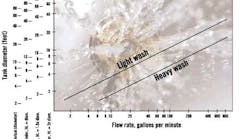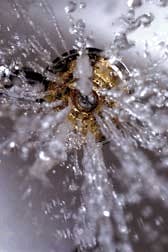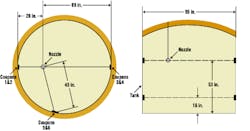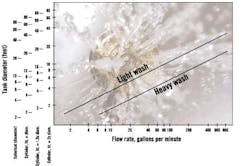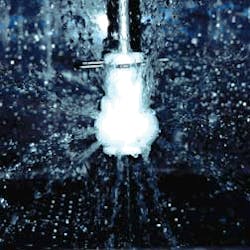Once you decide to change from manual tank washing to an automated process, you will find a mind-boggling array of tank-washing nozzles and machines on the market. They are available from more than a dozen manufacturers, and in countless shapes, sizes and configurations. Some work better than others, and some cost more than others. However, price is not always an indicator of value.
Engineers often find that very little information is available to help make the selection. Each supplier has its own sales literature, but only direct experience will tell you that a model from manufacturer X is better than one from manufacturer Y. Even experiences shared among colleagues are suspect if operating conditions are not similar.
Testing performance
Given the scarcity of objective information, one company decided to conduct a testing program to make direct controlled tests of tank washers under similar conditions and generate directly comparable information.* Although it would have been possible to analyze performance based on nozzle impact measurements or other lab approaches, actual residue or "soil" removal efforts were deemed more realistic and consistent with actual applications.
The testing began with identification of a representative tank and selection of a test soil that could be applied in a consistent manner. The soil selection was critical because the material needed to be difficult to remove, with characteristics that would make the evaluation quantifiable. All aspects of the test were designed to ensure repeatable results.
Although tests of competitors' units were considered, the company ultimately made the selection from its own product line. The intent of the experiment was primarily to test various design configurations instead of to measure one manufacturer against another. All the units tested are standard catalog designs taken right off the shelf. See Fig. 1.
Figure 1. Test Tank Sample
The testing program used a poly tank measuring 95 in. in diameter by 89 in. in height.
For the tests, coupons were designed and mounted in the walls of a 2,500-gallon (gal.) tank. The soil was the dried Elmer's Glue-All product, which is a water-soluble polyvinyl acetate (PVA) resin. The company formulated a method that called for running the nozzle at a specific pressure for 10 minutes using room temperature water, and then evaluating the material removal from the coupons. After running 30 tests on 15 different selected tank-washing nozzles and reading 180 coupons, the company felt it had enough data to draw some basic conclusions about the nozzles ," and about tank washing in general.
The test results did not point out a specific type of tank washer as a "universal best" for all applications. However, the results did provide more information about cleaning process and practices.
Understanding the cleaning task
Tank-washing nozzle selection must begin with an understanding of the specific cleaning process. Look at the task in front of you and ask:
What am I washing out? What is the soil composition?
How does the soil actually come off the walls of the tank?
What is the interaction of the soil and cleaning solution?
What do I expect the liquid to do when it hits the walls?
How far is the target surface from the nozzle, vertically and horizontally?
These are key questions that will help you analyze a cleaning task. Once you understand what you are dealing with, you can choose a nozzle with appropriate performance attributes. You need to keep in mind three major variables: impact, flow rate and distance.
Impact
How much impact is required to loosen and remove the soil? If the soil comes off easily and rinses away, your nozzle choice will not be difficult. Just about any tank washer will work.
On the other hand, more aggressive soils (such as dried glue) come off faster with the help of the spray impingement. Impact helps erode the soil and can lift it off the surface.
In the previously mentioned test situation, the best-performing nozzles were those that generated spray impact, even limited amounts, and delivered it frequently. When tested head to head, a small rotating tank washer outperformed a static spray ball, even though the rotating nozzle used less than one-third the liquid volume of the spray ball. The constant sweeping action combined with direct spray impact vastly improved the process.
So, how do you evaluate a given design and estimate its impact characteristics? When comparing two units, how do you determine which is the better choice?
The answers typically are a function of flow for a given orifice. In other words, you should be looking for a spray head with the fewest number of nozzles for the highest flow rate you can tolerate. However, this scenario brings with it some interesting trade-offs, including:
Time vs. liquid consumption. Which is more important, liquid use or time? A large-capacity tank washer typically will clean faster than a similar unit with a smaller flow. However, the efficiency (amount of cleaning per water volume) often decreases with the larger unit. A smaller tank washer running for a longer time often can do the same cleaning job using less liquid than a larger one running for a shorter time.
Pressure vs. impact. Increased pressure can mean decreased impact. With tank washers, especially small free-spinning units (<50 gallons per minute [gpm]), the optimal pressure can be as low as 20 pounds per square inch (psi) to 30 psi. A higher pressure will not increase impact. It might even decrease impact while using more liquid.
Rotation vs. impact. Speed hurts. Free spinning reaction-driven units can rotate too fast. This does not help the droplet propagation. Controlled rotation designs help minimize this effect, but the difference depends on the nature of the process.
Flow vs. impact. If you need to increase impact, increase flow, not pressure. Go to a larger-flow unit and keep the pressure down.
Nozzle size vs. quantity. Watch the nozzle count. Fewer nozzles keep the individual orifices large, and large nozzles generate large droplets with higher impact. Although fewer nozzles usually are better, there is a trade-off. When only a few nozzles are present, they must be very wide angle, and wide-angle flat fans tend to have lower impact. The optimum nozzle count is four, with three coming in second. Five or more nozzles necessitate smaller orifices.
Distance vs. impact. Distance does not help. The farther the tank wall is from the nozzle, the less the impact. Keep the nozzle sized appropriately for the tank. See Fig. 2.
Figure 2. Tank-Washing Nozzle Selection
This chart can assist in the selection of a tank-washing nozzle by calculating the flow rate required based on interior surface area.
Flow rate
What is the operational flow of the unit, and how is it distributed? "How much liquid does it take to wash my tank?" is a common process-specific question, but guidelines do exist.
One of the most common rules of thumb is 2.5 gpm to 4.0 gpm per foot of linear circumference for vertical cylindrical tanks with a height of less than four times the diameter. Another is 0.25 gpm to 0.40 gpm per square foot of interior surface for square tanks or those with more complex shapes. Sometimes the values go even higher.
These guidelines originated around the process of tank washing with stationary spray balls and assume all surfaces are being sprayed at the same time. The testing suggested this process is not efficient.
Instead, the tests indicated that the sweeping action of a rotating nozzle increases the cleaning efficiency substantially. For an appropriately sized unit in which the soil is not highly aggressive, it would be better to use a guideline closer to 1.0 gpm per foot of circumference. For other tank configurations, a guide of 0.1 gpm per square foot of interior also will work.
These numbers might be too low if the cleaning action is particularly difficult. The ultimate selection is something you will have to base on testing and experience.
The liquid's placement in the tank can be just as critical. Is the spray hitting where the soil is? Tank washers offering 360-degree coverage ," a common design ," cover the entire interior, including the top and bottom. Some shadow exists directly overhead, but a good design minimizes this. In a cylindrical tank of roughly equal height and diameter, this means less than half the spray hits the vertical walls. Most solution washes the top and bottom. However, units are available that omit straight-up or straight-down spraying, concentrating more of their efforts on the walls.
Tank-washing machines that rotate on two axes spend most of their effort washing the areas immediately above and below the unit and have the least power directly opposite themselves horizontally. Although this scenario is unfortunate, a better practical approach to washing large tanks is currently not available.
Distance
What is the distance from the target surface to the tank washer? Distance is the enemy of effective cleaning. Get as close as you can to the walls. To accomplish this, you might have to wash with more than one unit or from more than one insertion point.
Keep in mind that vertical distance is just as important as horizontal distance. If your tank is only 4 feet (ft.) in diameter but 10 ft. tall, do not fool yourself into thinking the wall is only 2 ft. away from the tank washer. As mentioned earlier, no specific tank washer design jumped out of the selection as a clear front runner. No guarantees are possible without a direct analysis of a specific cleaning process.
Available in an array of shapes, sizes and configurations, tank-washing nozzles and machines are available from more than a dozen manufacturers.
Suggested cleaning guidelines
Easy cleaning processes. A good example of an easy cleaning process is when paint is rinsed out of a tank using a process solvent. The solvent dilutes and rinses away the residue, assuming the residue has not dried.
If the cleaning task is not complex and the tank is not very large, just about any tank washer will work. If the tank is less than 8 ft. to 10 ft. in diameter, a small, inexpensive free-spinning unit in stainless steel or plastic should fit the bill. The orifices can be flat fans, slits or solid streams.
For simple rinsing, remember to:
Make sure the nozzle has sufficient spray coverage to hit all areas needing rinsing.
Verify that the spray can reach far enough at the operating pressure to hit the most distant points.
Keep the pressure appropriate for the design. More is not always better.
Make sure the flow rate is at least 0.1 gpm per square foot of interior surface. A flow less than that might not provide sufficient wash down the walls to cover areas where the nozzle might be weak.
Place the nozzle in the center of the tank about one-third of the way down from the top.
Consider the need for more than one nozzle to cover everything if internal obstructions exist.
Moderately difficult applications. As the cleaning task becomes more difficult with a more aggressive soil, the washer choice becomes more critical. An example of this type of application involves removing a fat- or grease-based product residue using a hot solution of sodium hydroxide (0.5 percent to 2 percent typically). Free-spinning units still might work well, especially those with higher flow rates.
Designs with friction bearings (no rolling elements) tend to turn more slowly naturally, helping to maintain spray effectivness. Controlled rotation designs also can improve the impact. Tank-washing machines probably are not needed at this level, however.
Be sure to:
Watch your pressure. If possible, test with your unit at various pressures to find the optimum combination or cleaning effectiveness, liquid consumption and washing time.
Size the unit appropriately. Use at least 0.15 gpm per square foot of interior surface. Maybe even 0.2 gpm or more is appropriate if your system can support it.
Make sure your equipment can take water out of the tank as fast as you need to put it in. Once you determine how much liquid you need to put in the tank to clean it, make sure the liquid can drain just as quickly. If the tank floods, it will reduce the cleaning effectiveness.
Do not waste coverage where it is not needed. If you do not need to wash the top, buy a unit that does not spray straight up. This will concentrate the washing liquid where it will do the most work.
Count the number of nozzles. Look for a head with three to five large flat fan orifices. These will minimize atomization and loss of impact. Turn away from slit or solid-stream orifices for these more difficult applications.
Very difficult applications. An example of a tough application includes the removal of latex residue from a reactor, especially heat-transfer surfaces. The material does not dissolve readily and impact is the principal way to remove it.
For very difficult cleaning processes, everything has to work its best. Limits likely exist on the amount of liquid you can use, so look at the trade-offs carefully.
This type of job is too difficult for free-spinning units, especially those with ball bearings. Look for something with controlled rotation. Solid-stream nozzles will make "stripes;" you need full coverage, preferably with flat-fan nozzles. Most of the same points for moderately difficult situations apply.
In addition, you should:
Consider a tank-washing machine using large solid streams.
Keep in mind that the impact will be enhanced if the amount of water is increased instead of the amount of the pressure. However, the larger the tank washer, the better it can tolerate and profit from high-pressure liquid.
If possible, consider hot water and available cleaning chemicals. Both can augment nozzle performance and make the task more manageable.
Conclusion
Tank washing or a clean-in-place (CIP) system can benefit from an appropriately chosen tank-washing nozzle. Many facets of the selection process are dictated by the nature of the cleaning requirements in your plant.
The first and most critical step is a thoughtful analysis of the specific cleaning task. This begins with an understanding of the nature of the "soil" and how it interacts with the cleaning solution. That knowledge will dictate the amount of cleaning solution and the best way to apply it for maximum effectiveness. From that point, the tank washer selection is much easier, and your probability of success will increase dramatically.
Welander is engineering director of Lechler Inc., St. Charles, Ill. Contact him at (800) 777-2926.
